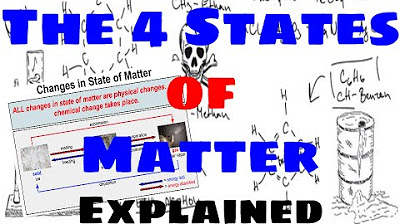Phase Changes, Heats of Fusion and Vaporization, and Phase Diagrams
Summary
TLDRIn this video, Professor Dave explains the various phase changes of matter, including melting, freezing, boiling, condensation, sublimation, and deposition. He delves into the concept of enthalpy and how heat energy is involved in these processes. The video covers key concepts such as vapor pressure, boiling points, and how atmospheric pressure affects the boiling point. Additionally, phase diagrams are discussed, illustrating how different substances behave at varying temperatures and pressures. The video provides clear insights into the physical transformations of matter, focusing on the unique behaviors of water and carbon dioxide.
Takeaways
- 😀 Melting and freezing occur between solids and liquids, while boiling and condensing occur between liquids and gases.
- 😀 Sublimation (solid to gas) and deposition (gas to solid) are unique phase changes that skip the liquid phase.
- 😀 Each phase change involves a change in enthalpy, which is the heat energy content.
- 😀 As temperature increases, the liquid's vapor pressure rises, leading to boiling when the vapor pressure equals atmospheric pressure.
- 😀 The normal boiling point of a liquid is measured at one atmosphere of pressure, and it decreases with altitude.
- 😀 The freezing point is the temperature at which a liquid becomes a crystalline solid, while the melting point is the reverse process.
- 😀 The temperature does not rise during phase changes, as heat energy is used to break molecular bonds or disrupt lattice energy.
- 😀 Heat of fusion is the energy required for melting, while heat of vaporization is needed for boiling.
- 😀 Phase diagrams visually represent the phases of a substance based on temperature and pressure.
- 😀 Water's phase diagram shows that the solid-liquid line slopes up and left because ice is less dense than water.
- 😀 Carbon dioxide has a different phase diagram, where the liquid form is less dense than the solid, and CO2 never exists as a liquid at normal atmospheric pressure.
Q & A
What are the main phase changes discussed in the video?
-The main phase changes discussed are melting, freezing, boiling, condensing, sublimation, and deposition. Melting and freezing occur between solids and liquids, while boiling and condensing happen between liquids and gases. Sublimation is the transition from solid to gas, and deposition is the transition from gas to solid.
What is the significance of enthalpy in phase changes?
-Enthalpy plays a key role in phase changes because each process—such as melting, boiling, sublimation, or condensation—requires or releases a specific amount of heat energy. This energy change is essential for the phase transition to occur.
How does temperature affect the vapor pressure of a liquid?
-As temperature increases, the vapor pressure of a liquid also increases because more particles gain enough energy to escape from the liquid phase and enter the gas phase. Eventually, the liquid reaches its boiling point, where the vapor pressure equals the atmospheric pressure.
Why does water boil at a lower temperature at higher altitudes?
-Water boils at a lower temperature at higher altitudes because atmospheric pressure decreases with altitude. Since the boiling point occurs when the vapor pressure equals the atmospheric pressure, a lower atmospheric pressure means the liquid boils at a lower temperature.
What is the difference between freezing and melting points?
-The freezing point is the temperature at which a liquid turns into a crystalline solid, while the melting point is the temperature at which a crystalline solid becomes a liquid. For most substances, the freezing and melting points are the same temperature but represent opposite processes.
What happens to temperature during phase changes, such as melting or boiling?
-During phase changes like melting or boiling, the temperature does not increase even though heat is being added. The energy goes toward disrupting the molecular structure, such as breaking the lattice of ice or overcoming hydrogen bonds in liquid water.
What are the 'heat of fusion' and 'heat of vaporization'?
-The heat of fusion is the amount of energy required to change a substance from solid to liquid at its melting point, while the heat of vaporization is the energy needed to change a substance from liquid to gas at its boiling point.
What does a phase diagram represent?
-A phase diagram shows the states (solid, liquid, or gas) of a substance at different temperatures and pressures. It includes lines that represent equilibrium between two phases and a triple point where all three phases coexist in equilibrium.
How does the phase diagram of water differ from that of carbon dioxide?
-In the phase diagram of water, the line between solid and liquid slopes up and left because ice is less dense than liquid water. For carbon dioxide, the line slopes up and right because the liquid form is less dense than the solid. Additionally, at atmospheric pressure, carbon dioxide cannot exist as a liquid, which is why dry ice sublimates.
What is sublimation and why does dry ice sublimate?
-Sublimation is the process where a substance transitions directly from solid to gas, bypassing the liquid phase. Dry ice (solid carbon dioxide) sublimates because, at atmospheric pressure, carbon dioxide cannot exist as a liquid and directly turns into gas when exposed to heat.
Outlines

このセクションは有料ユーザー限定です。 アクセスするには、アップグレードをお願いします。
今すぐアップグレードMindmap

このセクションは有料ユーザー限定です。 アクセスするには、アップグレードをお願いします。
今すぐアップグレードKeywords

このセクションは有料ユーザー限定です。 アクセスするには、アップグレードをお願いします。
今すぐアップグレードHighlights

このセクションは有料ユーザー限定です。 アクセスするには、アップグレードをお願いします。
今すぐアップグレードTranscripts

このセクションは有料ユーザー限定です。 アクセスするには、アップグレードをお願いします。
今すぐアップグレード関連動画をさらに表示

Science 8 - Quarter 3 Week 3-4 | Phase Changes

Grade 9 Chemistry Lesson 1 - Matter and the Particle Theory

Bab 2 Zat dan Perubahannya #2 (Perubahan Wujud Zat) | IPA SMP Kelas 7 | Sekolah Penggerak

SCIENCE 7: Quarter 1-LC 5: PHASE CHANGES OF THE STATES OF MATTER| MATATAG CURRICULUM

The Four States of Matter - Explained

Changes of State | Matter | Physics | FuseSchool
5.0 / 5 (0 votes)
